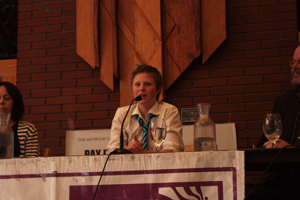For the first time in history, the debt Americans owe due to college-related costs is higher than the amount they owe in credit card debt by more than $5 billion. Current, former and future students alike are being hit with questions about financing their education, which set the stage for the Center for Gender Equality’s first Brown Bag event of the year, a discussion on student loans and gender.
Four panelists from various backgrounds were present to respond to a series of questions that were on the audience’s mind. Present on the panel were Jim Moore, director of the Politics and Government department; Krispin Jewks, a recent graduate; Lisa Szefel, director of FYS and a history professor; and Katrina Lungren, a senior and current co-chair for the CGE.
The lecture was centered around National Voter Registration Day, as this election is crucial for student loan rates. “Obama is really the only one who’s making it possible for my generation to go to college,” said Lungren.
While Szefel echoed Lungren’s statements, Moore had a different opinion. “Congress is where the real change is going to happen and unless we suddenly see a Democratic majority, I remain pessimistic.”
In terms of the amount of debt students will take out, Director of Financial Aid Mike Johnson stepped in to specialize the information for Pacific students.
“The average amount of student loans taken out by a Pacific student is about $25,000,” he said. “However, because all of our students are required to go through financial entrance counseling, our default rate is only 2 percent.”
Still, this isn’t a small number and with the rising interest rates, it could be more difficult in the coming years for students to afford their education.
“Today, loans for things like home mortgages are cheaper than they have ever been,” Moore explained. “Unfortunately, student loans are at an all-time high.”
In terms of gender, the ladies had much to say. “I graduate in May and one of my aspirations has been to join the PeaceCorps,” said Lungren. Many people choose to enlist in some sort of service to pay off or defer their student loans. However, this proves difficult for many women.
“The military offers many positions to those with either very specific skill sets, or to men,” said Lungren.With women still making less than men in the workforce, it will inevitably take a woman longer to repay her debt.
Arguably, the simplest way to pay back your loans is to not take them out at all. The panel suggested everything from a visit to the fellowships office to a look around the library and even the Internet. “I found a great website called fastweb.com, which allows you to find tons of different scholarships through one portal,” explained Lungren.
The Public Service Loan Forgiveness Program was also a subject of discussion. For those interested in public education, medicine or military service, your loans are eligible for forgiveness after 120 payments have been made on the loan, as a “thank you” by the government. Though taxes must be paid on the forgiven portion, this is still a great opportunity.
Despite all of that, loans are a very helpful part of a student’s financial aid package, and are completely navigable.
Jewks speaks from experience; “Educate yourself as much as possible. Stay on top of your loan payments, and keep your options open.”


Leave a Reply